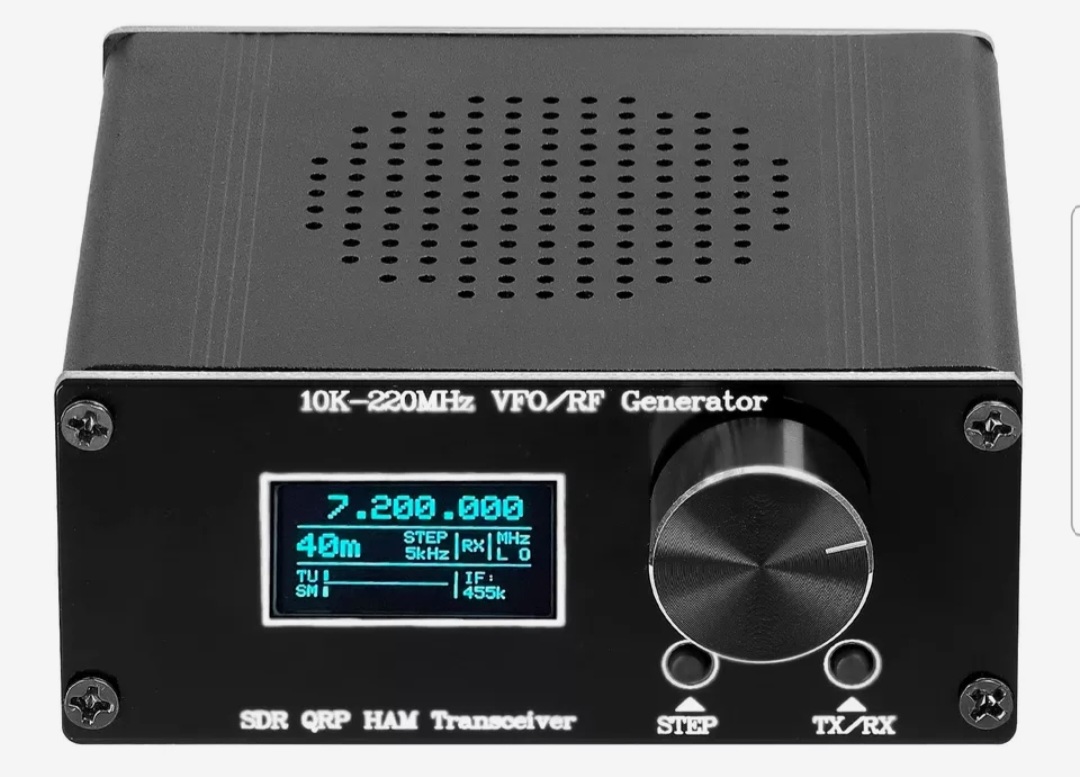10K-220MHz VFO/RF GENERATOR using Si5351a
( SDR QRP HAM Transceiver )
November 25, 2022 release
automatic translation by GOOGLE

Fig.1
The product shown in Fig. 1 is offered from the Far East.
However, since this is only a frequency generator and by no means a HAM transceiver
that can be operated independently, the advertising has to be described as
very full-bodied.
What do you get for it?
A solid housing contains a board with a Si5351a-PLL,
ARDUINO-compatible processor, a few buttons and a rotary encoder used for
frequency tuning. An OLED display is also used to show frequencies and other
operating settings. The device has an internal battery that can be charged
via a USB-C socket and can also be continuously supplied via the same connection.
Output frequencies in the range from 10 KHz to 225 MHz can be set using the rotary encoder. Their signals are available on a SMA jack found on the back panel. Increments from 10 Hz to 1 MHz can be selected via a button on the front. Different frequency bands can also be quickly selected using a button combined with the rotary encoder. A positive note was the frequency accuracy of the output signals, at least in the example I tested, which resulted in a frequency error of only a few 100 Hz in the 2m band, for example.
The signals output when using the software version provided in the delivery state are intended for use with single supers at an IF of 455 KHz and are each this amount below the frequencies shown on the display. Depressing the "TX/RX" button causes this offset to be canceled. The sense of this arrangement does not open up to me because of the momentary-only button used, because you would have to keep it pressed all the time for broadcasting. Also, transceivers with an IF of 455 KHz should now be rather rare!
ConclusionOutput frequencies in the range from 10 KHz to 225 MHz can be set using the rotary encoder. Their signals are available on a SMA jack found on the back panel. Increments from 10 Hz to 1 MHz can be selected via a button on the front. Different frequency bands can also be quickly selected using a button combined with the rotary encoder. A positive note was the frequency accuracy of the output signals, at least in the example I tested, which resulted in a frequency error of only a few 100 Hz in the 2m band, for example.
The signals output when using the software version provided in the delivery state are intended for use with single supers at an IF of 455 KHz and are each this amount below the frequencies shown on the display. Depressing the "TX/RX" button causes this offset to be canceled. The sense of this arrangement does not open up to me because of the momentary-only button used, because you would have to keep it pressed all the time for broadcasting. Also, transceivers with an IF of 455 KHz should now be rather rare!
Thus, the generator is hardly useful, at least with its
original software in my opinion. For this reason, it was examined whether
and, if so, what options exist for using other software versions. It was
found that any Arduino sketches could be uploaded with the IDE without any
problems if the setting to be selected for boards of the type NANO was used.
The firmware version used for the generator was apparently largely based on descriptions of proven VFO projects available on the Internet [1], [2]. It therefore made sense to use the corresponding sketches again as a reference for variants that meet our own requirements. For use with the existing hardware of the generator, however, the processor ports used for the switch applications first had to be determined and the corresponding firmware adjustments made:
STEPS: #9The firmware version used for the generator was apparently largely based on descriptions of proven VFO projects available on the Internet [1], [2]. It therefore made sense to use the corresponding sketches again as a reference for variants that meet our own requirements. For use with the existing hardware of the generator, however, the processor ports used for the switch applications first had to be determined and the corresponding firmware adjustments made:
RX/TX: #10
BAND: #A0
The rotary encoder is controlled via port inputs #2 and
#3, whereby these can be exchanged in the firmware for a reversal of the
direction of rotation, if required.
The function of the following buttons has been changed for this: "RX/TX" is now "Band Selection" and button of the increment button is for saving the current frequency setting.
NEW
Attached is a modified version [3] of one of the programs from CesarSound
with the option of saving frequency settings for later use. The function of the following buttons has been changed for this: "RX/TX" is now "Band Selection" and button of the increment button is for saving the current frequency setting.
link list
[1] https://create.arduino.cc/projecthub/CesarSound/10khz-to-120mhz-vfo-rf-generator-with-si5351-and-arduino-3a7cad
[2] https://www.hackster.io /CesarSound/10khz-to-225mhz-vfo-rf-generator-with-si5351-version-2-bfa619
[3] http://www.kh-gps.de/VFO_STORE_ASIA_V1.0.zip
[2] https://www.hackster.io /CesarSound/10khz-to-225mhz-vfo-rf-generator-with-si5351-version-2-bfa619
[3] http://www.kh-gps.de/VFO_STORE_ASIA_V1.0.zip
